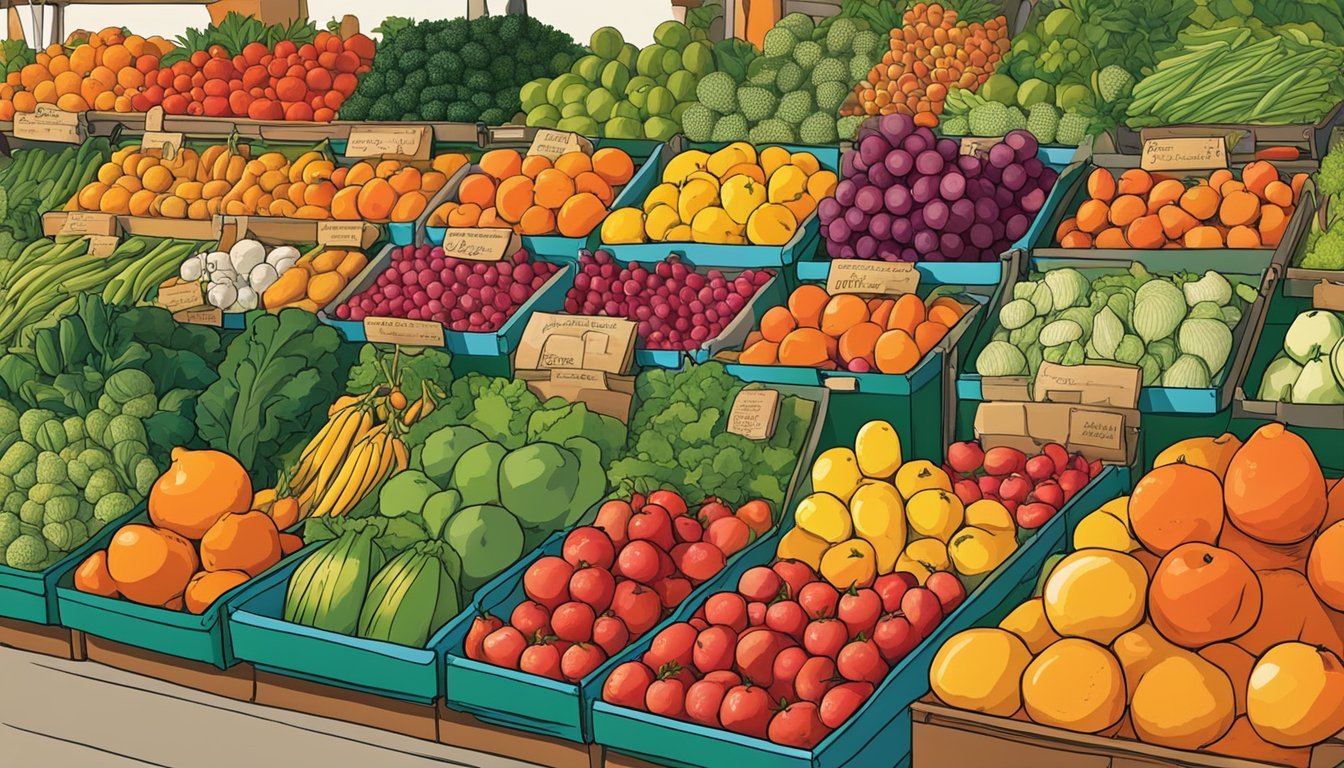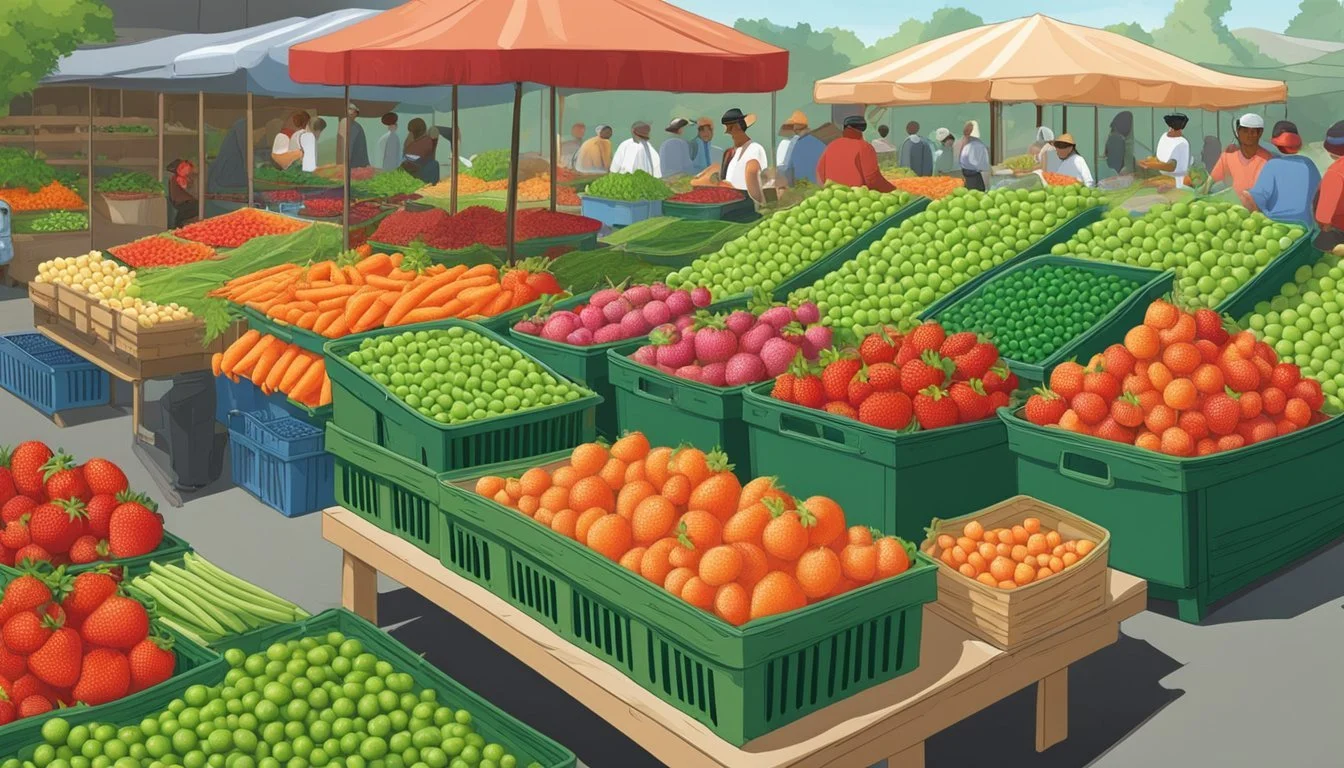Seasonal Fruit and Vegetables March
Optimize Freshness and Flavor
This Article is Part of Our Guide to Seasonal & Local Produce in the USA
As March arrives, the transition from winter to spring begins to unfold, influencing the variety of produce available at markets. Seasonal produce during this time not only reflects the changing climate but also offers a range of flavors and nutritional benefits. Embracing the fruits (What wine goes well with fruit?) and vegetables that are in season in March encourages a diverse diet and supports local agriculture.
Spring produce begins to make its appearance, with early-season fruits and vegetables arriving at the farmer's markets and grocery stores. Vegetables such as artichokes (What wine goes well with artichokes?) and asparagus (how long does asparagus last?)become more abundant, offering their fresh, unique flavors. These vegetables are often enjoyed for their versatility in recipes, from grilling to steaming. Spring fruits are on the cusp of their season, hinting at the sweet and vibrant bounty that's to come with warmer weather.
The benefits of consuming seasonal fruits and vegetables in March include not only the optimal taste but also the nutritional peak of the produce. Foods that are harvested during their appropriate season are often more flavorful and nutritionally dense. Moreover, selecting produce that naturally thrives during this time supports sustainability, as it often requires fewer resources to grow and transport.
What’s in Season in March in Your State?
Benefits of Eating Seasonally
Eating seasonally entails consuming fruits and vegetables during their natural harvesting period. One significant advantage is enhanced flavor. Produce grown and picked at its peak naturally tastes fresher and more full-bodied compared to out-of-season counterparts often picked before ripening and transported long distances.
Fresh produce also tends to be more nutrient-rich. Key vitamins and minerals can degrade over time; thus, consuming fruits and vegetables soon after harvest ensures a higher nutrient content. For instance, leafy greens consumed during their spring peak will have had optimal conditions for developing their nutrient profile, which can include vitamins A, C, and K.
In the context of nutrients, the term superfood often arises. It refers to produce with high levels of desirable nutrients. Seasonal fruits and vegetables can sometimes fall into this category due to their increased concentration of antioxidants and other beneficial compounds.
Here is a brief overview:
Flavor: Seasonal produce often boasts a superior taste.
Freshness: Freshly harvested, it's less likely to have lost nutritional value due to transport or storage.
Nutrient density: At its peak, seasonal produce can offer more vitamins and minerals.
Superfoods: The term is best applied to nutrient-dense, fresh, seasonal produce.
Choosing seasonal produce supports a sustainable food cycle, reducing the need for long-distance transportation and storage, which benefits not just the consumer's health, but the environment as well.
Seasonal Fruits in March
March brings a diverse palette of fruits that are at their peak, offering a perfect balance of tartness, sweetness, and exotic flavors. Consumers can find a variety of citrus fruits along with some tropical options that can be used in a variety of culinary applications.
Citrus Fruits
March is an excellent time for citrus fruits, which are known for their vibrant flavors and high vitamin C content. Oranges, grapefruits, lemons, and tangerines are all in their prime. These fruits are versatile, perfect for eating raw or incorporating into recipes.
Oranges: Sweet and juicy, ideal for juicing or as a snack.
Grapefruits: Tangy and slightly bitter, great in salads (What wine goes well with salads?).
Lemons: Perfect for adding a zesty flavor to dishes or making lemonade.
Tangerines: Easy to peel and sweeter than oranges, a favorite for all ages.
Exotic Varieties
The market also offers more exotic fruit options such as kiwi, mango, and pineapple. These tropical fruits add a burst of sweetness and color to dishes.
Kiwi: A small fruit with a tangy flavor and a bright green interior.
Mango: Sweet, juicy, and perfect for salsas, smoothies, or eaten on its own.
Pineapple: Known for its sweet and sour taste, ideal for fruit salads or as a pizza topping.
Pome and Stone Fruits
While pome and stone fruits are not typically at their peak, you can still find late-season apples and pears that retain their texture and flavor well.
Apples: Crisp and versatile, suitable for baking or eating raw.
Pears: Soft and sweet, can be roasted or poached for a dessert.
Berries and Tropical Fruit
While berries are not in their prime season, tropical fruits like avocado thrive in March. These are filled with healthy fats and have a creamy texture that enhances any dish they're added to.
Avocado: Rich and buttery, excellent in salads, sandwiches, and as guacamole.
Selecting and Storing Tips
When selecting fruit, look for firmness in citrus fruits and a slight give in tropical fruits. Fruits like pineapples should have a sweet aroma. Store citrus fruits at room temperature if using soon, or in the fridge for a longer shelf life. Tropical fruits like avocados ripen well on the counter but can be refrigerated once ripe to prolong freshness.
Preparation and Recipe Ideas
Citrus fruits can be juiced, blended into smoothies, or zested to add a punch to baked goods.
Exotic fruits like mango and pineapple are excellent when diced and added to salsa or skewered for grilling.
Incorporate avocado into your diet by slicing it for toast or mashing it for dips.
Use lemons to create tangy dressings for salads or add a slice to water for a refreshing twist.
Seasonal Vegetables in March
As spring approaches, March heralds a bounty of fresh vegetables, offering both variety and flavor. Shoppers can look forward to a range of leafy greens, cruciferous vegetables, root and bulb types, as well as different alliums, each with their own unique cooking methods and recipe applications for a healthy diet.
Leafy Greens
Arugula: Peppery and versatile, perfect for salads.
Spinach: Tender and rich in iron, ideal for salads and as cooked greens.
Kale: Sturdy and nutrient-dense, suitable for cooking or as a salad base.
Mustard Greens: Spicy and flavorful, can be sautéed or used in soups.
Watercress: Crisp and slightly tangy, excellent for salads and garnishing dishes.
Cruciferous Varieties
March sees a variety of cruciferous vegetables that can be prepared in numerous ways:
Broccoli: Can be steamed, roasted, or used in stir-fries.
Cauliflower: Ideal for roasting or as a low-carb rice or mash substitute.
Cabbage: A staple in slaws, sautéed dishes, (What Wine Pairs Best with Sautéed Dishes) and ferments like kimchi.
Brussels Sprouts (how long do brussels sprouts last?): Best when roasted to a golden crisp (how long does golden crisp last?) or sautéed with garlic.
Root and Bulb Vegetables
These vegetables remain firm favorites through March:
Carrots: Sweet and crunchy, roasted or as part of mirepoix.
Beets: Earthy flavor, roasted, in salads, or pickled.
Radishes: Offer a sharp bite, eaten raw or pickled for an extra zing.
Fennel (how long does fennel last?): Anise-flavored and crisp, raw in salads or braised for a tender side.
Alliums and Others
Alliums provide the flavor foundation for countless recipes:
Leeks: Mild and sweet, ideal for soups and potato dishes.
Green Garlic: Gentle garlic flavor, used fresh or lightly cooked.
Shallots: Delicate and slightly sweet, enhancing dressings, and sauces.
Cooking Techniques for Vegetables
Different cooking methods can bring out the unique flavors and textures of March vegetables:
Steam: Retains color and nutrients, best for spinach or peas.
Roast: Enhances natural sweetness, perfect for carrots and Brussels sprouts.
Grill: Adds smokiness, a great option for asparagus and spring onions.
Blanch: Preserves crispness and color, suitable for green beans and broccoli.
Healthy and Flavorful Recipes
Recipes that showcase March's vegetables maintain health benefits and taste:
Side Dishes: Roasted beets with a sprinkle of goat cheese or caramelized Brussels sprouts.
Salads: Fresh spinach salad with sliced strawberries and balsamic vinaigrette.
Soups: Creamy cauliflower soup or hearty cabbage stew.
Herbs and Flavor Enhancers
March brings a variety of herbs to the culinary forefront, enhancing dishes with their fresh flavors. Rosemary, a robust herb with a pine-like aroma, thrives in the cooler transition from winter to spring. It holds up well in hearty dishes like roasted meats (What wine goes well with roasted meats?) and root vegetables.
Thyme is another versatile herb appearing in March, offering a subtle earthy flavor that pairs well with soups, stews, and poultry. Its delicate leaves are easily incorporated into a myriad of recipes.
Parsley, often used as a garnish, brings more than just a pop of color. With its bright, slightly peppery taste, parsley can enliven salads, dressings, and sauces. Curly and flat-leaf varieties are both commonly used, though flat-leaf, or Italian parsley, is preferred for its more pronounced flavor.
Sage, with its fuzzy leaves and savory taste, is perfect for infusing oils or complementing rich dishes (What wine goes well with rich dishes?) like pasta or pork. It's best used sparingly due to its strong flavor profile.
In addition to these herbs, March is an excellent time to utilize olive oil as a flavor enhancer. Extra virgin olive oil, in particular, adds a fruity, peppery dimension to fresh salads or as a finishing touch to warm dishes.
For seasoning, flaky salt is a chef's go-to for finishing plates. It not only enhances flavors but also adds a pleasant crunch. A pinch of flaky salt over a dish can elevate the taste and presentation without overpowering the natural flavors of the ingredients.
Herbs to look for in March:
Rosemary
Thyme
Parsley (both curly and flat-leaf)
Sage
Flavor enhancers:
Olive oil (extra virgin preferred)
Flaky salt
Incorporating these herbs and flavor enhancers can transform a dish, adding depth and character to March's seasonal offerings.
Monthly Produce Guide
March marks a transition from the cold winter months to the early signs of spring. Shoppers can find a mix of winter and spring produce on the market stands, providing a diverse range of flavors and nutrition.
Fruits that typically peak during this month include:
Strawberries: Beginning to come into season, these berries are a sign of the warmer days ahead.
Citrus fruits: Such as lemons, oranges, and grapefruits, are still abundant, offering a tangy burst of freshness.
Vegetables that are in season for March often consist of:
Leafy greens: Like spinach and kale, the cool weather retains their crispness and depth of flavor.
Root vegetables: Including carrots, turnips, and beetroots, are still readily available and ideal for hearty meals.
With this information, one can plan a nutrient-rich menu that aligns with the season's offerings. They can also support local agriculture by seeking out the season's produce using a regional map to guide them to farmers' markets and local grocers.
Here's a simple table for quick reference:
Seasonal Fruit Seasonal Vegetables Strawberries Spinach Lemons Kale Oranges Carrots Grapefruits Turnips - Beetroots
Shoppers are encouraged to embrace the seasonal variety of fruits and vegetables that March brings and to enjoy the flavors and nutritional benefits of produce at its peak freshness.
Gardening and Harvesting Tips
March is a pivotal month for gardeners, marking a period when the transition from winter to spring begins. Gardeners should prepare to plant a variety of crops and consider the timing for harvesting established ones.
Planting Tips:
Leafy Greens: They recommend starting with leafy greens such as lettuce, spinach, kale, and Swiss chard. These can be sowed directly into the ground or started indoors as seedlings before transplanting.
Root Vegetables: Early March is prime for planting carrots, radishes, potatoes, and beets. They mention these yield well when planted at this time.
Growth Management:
Pruning: It's crucial to prune off any branches killed by diseases like fire blight on apple and mountain ash trees. For cherries with black knot disease, one should make cuts one foot below the affected area. Always disinfect pruners with rubbing alcohol between cuts.
Harvesting Insights:
Gardeners should assess the maturity of any winter crops still in the ground. They might find some, such as parsnips, are sweeter post-frost and ready for harvest.
Cool-season vegetables that mature quickly can potentially be harvested if they were planted earlier. Radishes and some leafy greens may be ready.
Climate Considerations:
In warmer regions, gardeners may experience spring conditions, enabling more diverse planting.
Those in colder climates may need to start seeds indoors or in a protected space like a greenhouse.
This month necessitates gardeners' close attention to both the soil conditions and local weather patterns to ensure successful planting and harvesting schedules.
Food Sustainability and Locality
When discussing the sustainability of food systems, locality plays a significant role. Local food systems are composed of the networks between farmers, processors, and consumers within a defined area, which contributes to the community's economy and has less environmental impact. Local markets are platforms for selling produce within these systems, where seasonal fruits and vegetables are notable contributors.
Community engagement in local markets not only supports the area's economy but also promotes a sustainable lifestyle. The proximity of these markets to consumers often reduces transportation emissions, contributing to lower greenhouse gas emissions. A study calculated emissions based on diets and pointed out the reduction achievable by incorporating locally sourced, seasonal foods.
Here, the significance of locality is evident in March, particularly in regions with a clear seasonal climate such as Montana. Sustainable food consumption during this period involves preference for produce that is either stored effectively from previous harvests or grown in controlled environments like greenhouses. Such practices ensure a sustainable supply of fresh produce year-round.
The dialogue surrounding local and sustainable food consumption involves multiple players: farmers who adopt eco-friendly practices, markets that source and sell these goods, and consumers who make environmentally conscious choices. These elements interlace, forming a tapestry that both strengthens community bonds and benefits the planet.
Key highlights on the importance of locality in sustainable food consumption include:
Sustaining local economies
Reducing transportation emissions
Enhancing community marketplaces
Providing seasonal choices that align with sustainable diets
Conclusion
March heralds the arrival of spring and with it, a vibrant variety of fruits and vegetables that not only add color to one's plate but also contribute significantly to a healthy lifestyle. They procure their rich flavors from the natural ripening process of the season. Consumers benefit from both enhanced taste and nutritional value when they opt for these in-season selections.
Fruits like strawberries and pineapples become increasingly available and are perfect for infusing diets with vitamins and antioxidants. Vegetables, including asparagus and artichokes, come into their prime, offering an array of health benefits and adding a fresh taste to spring dishes. Incorporating these seasonal foods into one's diet supports both local agriculture and environmental sustainability.
The transition into spring is an ideal time for individuals to rejuvenate their meal plans and embrace the fresh produce that March has to offer. Consumption of these seasonal items can promote a well-balanced diet. Here, they find that what is good for the planet aligns with what is beneficial for personal health.
In recognition of the variety and availability of March's produce, individuals may explore new recipes and uses. From salads and soups to pastas and pestos, the incorporation of such ingredients can enrich the gastronomic experience while fostering a wholesome diet.
By aligning one’s shopping habits with the seasonal calendar, there's not only potential cost-saving but also an opportunity to innovate in the kitchen, ensuring that meals are both diverse and nutritionally rich.






